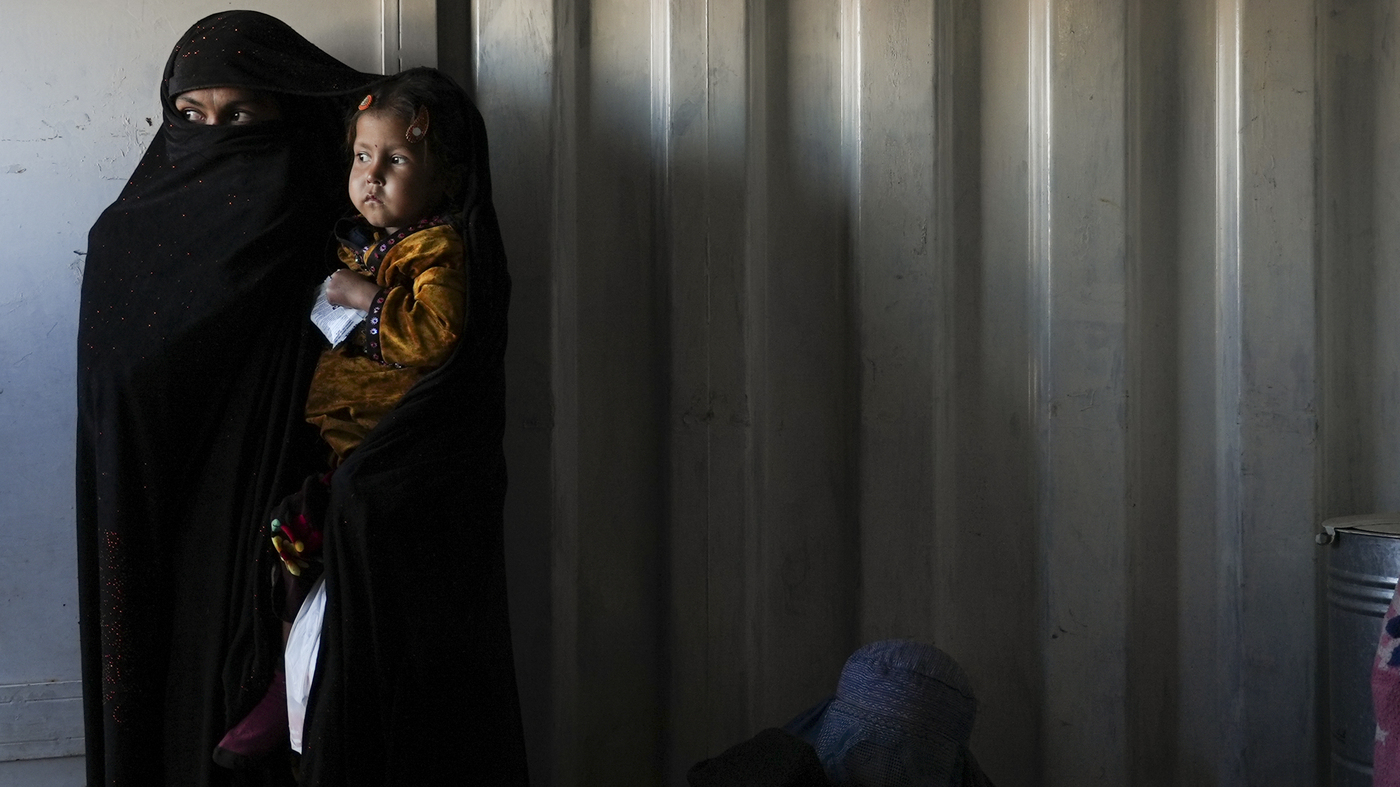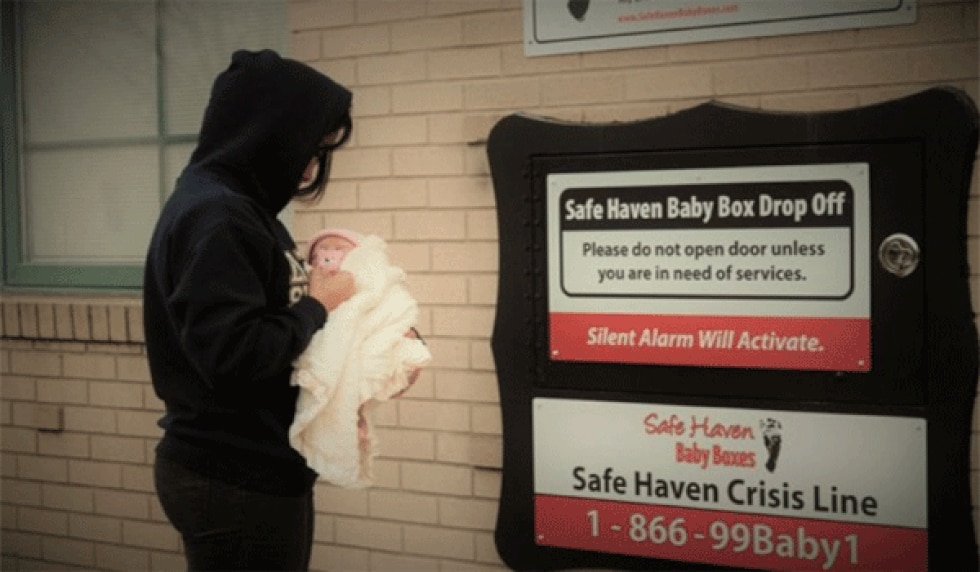
An Afghan woman waits in the makeshift clinic organized by World Vision at an encampment near Herat, Afghanistan.
Mstyslav Chernov / AP
hide caption
toggle legend
Mstyslav Chernov / AP

An Afghan woman waits in the makeshift clinic organized by World Vision at an encampment near Herat, Afghanistan.
Mstyslav Chernov / AP
SHEDAI CAMP, Afghanistan (AP) – In a sprawling colony of mud brick huts in western Afghanistan home to people displaced by drought and war, a woman fights to save her daughter.
Aziz Gul’s husband sold the 10-year-old girl in marriage without telling his wife, taking a down payment to be able to support his family of five children. Without that money, he told her, they would all starve. He had to sacrifice one to save the others.
Much of the growing number of poor people in Afghanistan are making desperate decisions like these as their nation slips into a vortex of poverty.
The aid-dependent country’s economy was already faltering when the Taliban seized power in mid-August amid a chaotic withdrawal of US and NATO troops. The international community has frozen Afghanistan’s assets abroad and suspended all funding, refusing to work with a Taliban government given its reputation for brutality during its previous rule 20 years ago.
The consequences have been devastating for a country battered by four decades of war, punitive drought and the coronavirus pandemic. Legions of state employees, including doctors, have not been paid for months. Malnutrition and poverty threaten the most vulnerable, and aid groups say more than half of the population faces severe food shortages.
“Day by day, the situation is deteriorating in this country, and especially children are suffering,” said Asuntha Charles, national director of aid organization World Vision in Afghanistan, which runs a health clinic for the people. displaced just outside the western town of Herat. .
“Today I was heartbroken to see families ready to sell their children to feed other family members,” Charles said. “So now is the right time for the humanitarian community to stand up and stay with the Afghan people.”
Organizing weddings for very young girls is a common practice throughout the region. The groom’s family – often distant relatives – pay money to close the deal, and the child usually stays with their own parents until they are at least 15 or 16 years old. bride and groom to take very young girls or even try to sell their sons.
But Gul, unusually in this deeply patriarchal, male-dominated society, resists. Married at 15, she says she would kill herself if her daughter, Qandi Gul, was forcibly taken away.
Gul remembers the moment when she found out that her husband had sold Qandi. For about two months, the family has been able to eat. Finally, she asked her husband where the money was coming from, and he told her.
“My heart stopped beating. I wish I could have died then, but maybe God didn’t want me to die,” Gul said. Qandi was sitting next to her mother, her hazel eyes gazing shyly under her sky blue scarf. “Every time I remember that night … I die and come back to life. It was so hard.”
She asked her husband why he had done it.
“He said he wanted to sell one and save the others. ‘You would all have died that way’ (he said.) I told him, ‘Dying was much better than what you did. . ‘”
Gul rallied her community, telling her brother and village elders that her husband had sold his child behind his back. They supported her and with their help she obtained a “divorce” for her child, but only on condition that she repay the 100,000 afghanis (about $ 1,000) her husband received.
It’s money she doesn’t have. Her husband fled, perhaps fearing that Gul would report him to the authorities. The Taliban government recently announced a ban on forcing women to marry or using women and girls as trading tokens to settle disputes.
The family of the bride-to-be, a man around 21 or 22, have made several attempts to claim the girl again, she said. She doesn’t know how long she will be able to push them away.
“I’m so desperate. If I can’t provide the money to pay these people and I can’t keep my daughter by my side, I said I would kill myself,” Gul said. “But then I think of the other kids. What’s going to happen to them? Who’s going to feed them?” Her eldest is 12 years old, her youngest – her sixth – barely two months old.
Now alone, Gul leaves the children with her elderly mother while she goes to work with people. Her 12-year-old son works to pick saffron after school. This is barely enough to feed them, and the saffron season is short, only a few weeks in the fall.
“We have nothing,” Gul said.
In another part of the same camp, Hamid Abdullah, a father of four, also sold his young daughters to arranged marriages, desperately seeking money to care for his chronically ill wife, pregnant with their fifth child.
Abdullah has borrowed money to pay for his wife’s treatments and cannot pay it back, he said. So three years ago, he received a deposit for his eldest daughter Hoshran, now aged 7, in an arranged marriage with an 18-year-old in their home province of Badghis. He is now looking for someone to buy his second daughter, 6-year-old Nazia.
“We have no food,” said Abdullah, adding that he also had to buy medicine for his wife, who would soon need more care. “She needs another operation, I don’t have a single afghani to pay for the doctor.”
The family who bought Hoshran are waiting until she is older before the full amount is paid, he explained.
But he needs money now for food and medicine, so he tries to arrange a marriage for Nazia for around 20,000-30,000 afghanis ($ 200-300).
“What should we do? We have to do it, we have no other choice,” said his wife, Bibi Jan. “When we made the decision, it was as if someone had removed part of my body.”
In neighboring Badghis province, another displaced family is considering selling their 8-year-old son, Salahuddin.
His mother, Guldasta, said that after days without eating anything, she told her husband to take the boy to the bazaar and sell him to bring food to others.
“I don’t want to sell my son, but I have to,” said the 35-year-old. “No mother can do this to her child, but when you have no other choice, you have to make a decision against your will.”
Salahuddin blinked and watched silently. Surrounded by some of his seven siblings, his lip quivered slightly.
Her father, Shakir, who is blind in one eye and has kidney problems, said the children had been crying from hunger for days. On two occasions, he says, he decided to take the boy to the bazaar and on two occasions he faltered, unable to go through with it. “But now I think I have no choice but to sell it.”
Buying from boys is believed to be less common than buying from girls, and when it does occur, it appears to be young boys being bought by families who have no sons. In her despair, Guldasta thought that such a family might want an 8-year-old.
The desperation of millions of people is clear as more and more people face hunger. By year-end, some 3.2 million children under 5 are expected to suffer from acute malnutrition, UN says
Nazia is one of them. The 4-year-old girl lay limp in her mother’s arms after visiting the World Vision health clinic.
Two years ago, Nazia was a chubby toddler, her mother Fatima said. Now his emaciated limbs are nothing more than skin covering the bones. Her little heart is beating visibly under her rib cage.
“The prices are high. Flour is expensive, cooking oil is expensive, everything is expensive,” Fatima said. “All day she asks me to give her meat, yogurt and fruit. We don’t have anything, and we don’t have the money to buy it for her.
Charles, World Vision’s country director for Afghanistan, said humanitarian aid funds were desperately needed.
“I am happy to see the promises are made,” she said. But the promises “must not remain promises, they must be seen as a reality on the ground”.




